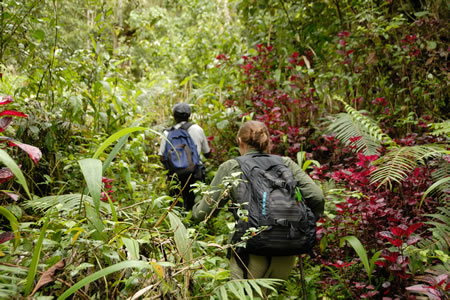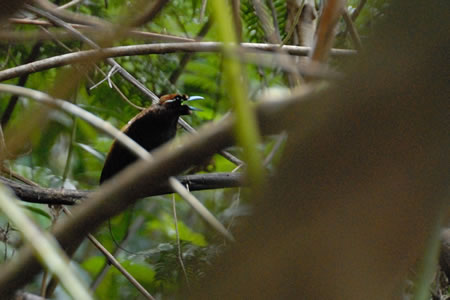English | Dutch |
|
| In search of the Birds of Paradise | |
Manokwari (Indonesia), June 9th 2009 |
|
There are a number of animal species that are high on everybody’s wish list for seeing them in the wild. Most of the time, these lists include species like the Lion, the Tiger, the Orang Utan and the Elephant. But on our wish list, the Birds of Paradise are also present. These spectacular birds, not only because of their colour and appearance, but also often because of their behaviour, are astonishing. The birds can mainly be found on the New Guinea Island, which consists of the independent country Papua New Guinea and the Indonesian province of Papua. We decided to travel to the town of Manokwari, in the western part of Indonesian Papua (the area is often also called ‘the vogelkop’). Manokwari is the perfect base to visit the Arfak Mountains. In the Arfak Mountains it is still possible to see a significant number of Birds of Paradise species (locally known as Cendrawasih). We got from the sparrow-doctor (see also the article: on the way with the sparrow-doctor), who we met earlier during our travels in Indonesia, the telephone number of the in Manokwari based woman Shita. She is connected to the Papuan Bird Club and is a source of useful information for a visit to the Arfak Mountains. She advised us to make use of the guide called Zeth, who is located in a very small village in the Arfak Mountains, a two hour drive from Manokwari. Zeth organises trekkings in the surrounding forests in search of the Birds of Paradise. The village is very basic. There is no electricity, no running water, no gas and no other sanitary facilities. There is also no shop, so you have to bring all the supplies that you need during your stay in the village. It seems to be the local culture that you do not only bring food for yourself, but also for the people you work with during your stay (cooks, guide, porters, etc). That we something we didn’t know. So, armed with bags of vegetables, potatoes and rice, we set off for the Arfak Mountains. |
|
 |
|
In search of the Birds of Paradise in the dense jungle |
|
When we arrive in the village, we immediately notice that the village is very poor. Also the guesthouse where we stay during our visit is very basic. The wooden guesthouse has five small rooms without doors, and in every room, Zeth built two wooden bunks. There are no mattresses or bed sheets, so we are glad that we brought them ourselves. Behind the guesthouse, there is a very ramshackle little wooden structure that contains the famous hole in the ground. There is no privacy (no door), so do your thing when nobody is around. Be sure to be fast, because otherwise you will be stung in your buttock by one of the many mosquitoes. There is no bathroom. So if we want to wash ourselves, we need to use a small bucket or go to the nearby river, where we probably share the river with one or more of the villages’ women doing the laundry. The cooking is done by some of the village women. The kitchen is of the type “open air” and the cooking is done on a traditional wood fire. Hygiene is unheard of. During our stay of five days, we never saw somebody washing their hands. Fortunately, we didn’t fall ill. During the days that we went to the forest in search of the Birds of Paradise, we got up very early. We left the guesthouse at 5.30 am to be sure to be on the right place at sunrise. There isn’t a lot of walking, because the forest immediately starts as soon as you leave the small village. But the paths are often steep and slippery, so it is wise to walk slowly and to keep your eyes focussed on the ground. It is still possible to see seven species of Birds of Paradise in the forests surrounding the village. The species are: the Magnificent Bird of Paradise, the Superb Bird of Paradise, the Black Sicklebill, the Buff-tailed Sicklebill, the Western Parotia, the Arfak Astrapia and the Long-tailed Paradigalla. We find ourselves very lucky because we saw six of them (we saw them all expect the Paradigalla). Our guide Zeth was really amazing. He knows all the calls of the 250 different bird species that can be found in the forest, and his eyes are sharp like a razor blade. It happened several times that he pointed out birds to us that we only saw after a couple of minutes looking in the dense jungle. The gift to see the birds very fast is probably something that he developed during the time that he was still a poacher. At that time, he was depending for his income on his capability to catch Birds of Paradise. But that is fortunately history. He now realises that the presence of these special birds is a gift from nature for his village and that the preservation will bring lot of money in the long term. He now earns his money by taking bird watchers into the forest who want to see the birds in their natural habitat. Also more and more other people of the village earn some extra money by working for the tourists (see also the column: “Ecotourism in the purest form”). Poaching still happens in other forests in the area. It seems that there is still a lot of demand from China. A dead bird brings in approximately 150,000 Rupiahs (= € 10.-) for the poacher. | |
 |
|
A Magnificent Bird of Paradise |
|
| Not only the colours and the shapes of the birds are amazing, also the behaviour is astonishing. Especially in the time that they ‘display’, the shows that they perform are one of a kind. During the display period, the mating takes place and the males want to impress the females as much as possible. For that reason, males make a displaying ground in the forest (some kind of a little theatre), where they perform their dances twice a day. The females come to take a look to see if the male is interesting enough to mate with. During our visit to the Arfak Mountains, two species were displaying, the Magnificent Bird of Paradise and the Western Parotia. Especially the display performance of the Western Parotia was unique. The bird was dancing on the ground like a mix of a ballet dancer and a hip hopper. We never saw such a thing before. It was amazing! (see also our video: “Cendrawasihs in the Arfak Mountains” and the photo impression ). Zeth made blinds (camouflages observation compartments) near the displaying grounds, which makes it possible to see the show from only a coupe of metres.
After three full days of birding, we travelled satisfied back to Manokwari. We stayed four nights and five days in the village, and the accommodation was very basic. We went to bed around seven in the evening because there is no electricity and no candles (tip: do not forget to bring candles). Because we brought too little food to feed seven stomachs (we only counted on four), we were sometimes a little bit hungry during the last days (tip: bring a lot of food). But it was worth it. We had a fantastic time and we saw thing that we couldn’t have imagined before. Nature is beautiful and we must do our utmost best to preserve it. | |